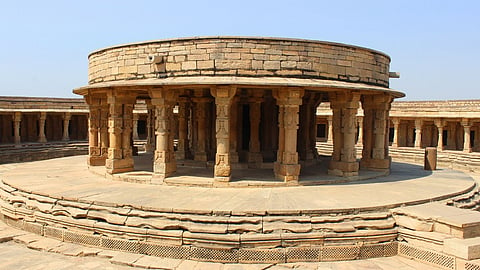
- HOMEGROWN WORLD
- #HGCREATORS
- #HGEXPLORE
- #HGVOICES
- #HGSHOP
- CAREERS
- ABOUT US
- CONTACT US

In early medieval India, as Buddhism declined and Hinduism absorbed Buddhism's more esoteric traditions, Dakinis — female spirits and deities found initially in Tantric Buddhism — converged with Yoginis, or minor goddesses and nature spirits found in Vedic and Tantric Hinduism. According to Hinduism, a Yogini is the divine feminine energy of the universe made incarnate as an aspect of Mahadevi or the Supreme Mother Goddess in the Shakti tradition. Beginning in circa 10th century CE, Yoginis were worshipped together in groups of 64, as manifestations of the Matrika or mother goddesses, in circular hypaethral — or open-air — temples across Central India. Today, the best-preserved example of these Yogini temples is located in Madhya Pradesh.
According to an inscription dated Vikram Samvat 1380 (or 1323 CE) found at the site, the 11th-century Ekattarso Mahadeva Temple, or the Chausath Yogini Temple in Mitaoli, in the Morena district of Madhya Pradesh, was commissioned by King Devapala of the Kachchhapaghata dynasty, which ruled over northwestern parts of Central India between 10th and 12th centuries CE.
The temple, situated on top of a small hill, is formed by a circular outer wall with 65 chambers — one for Mahadevi, and the rest for the 64 Yoginis — surrounding a circular inner sanctum dedicated to the Hindu god Shiva. According to the Archaeological Survey of India, the open-roofed temple was once a centre of Tantric, spiritual, astrological, and mathematical learning based on the transit of the sun.
Unlike other Yogini temples which are usually quite plain on the outside, the exterior surface of the outer wall in the Mitaoli temple was decorated with statues of couples flanked by maidens, most of which are now lost or badly damaged. The inner chambers, too, now contain images of the Hindu god Shiva, as opposed to the original images of Mahadevi and the 64 Yoginis. Although it is located in an earthquake-prone Seismic Zone 3 region, the temple has withstood many earthquakes since its construction in 11th century CE, with almost no visible damage.
Despite its close proximity to Gwalior, a major town in Madhya Pradesh, Mitaoli continues to remain one of the lesser-known tourist spots in India even today. The fastest and easiest way to reach the Chausath Yogini Temple is by car from Gwalior.
